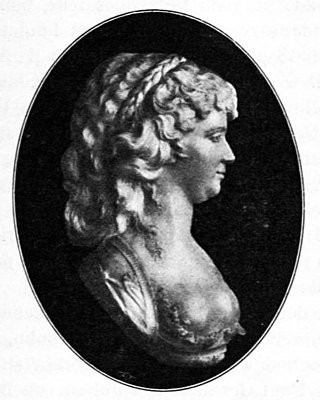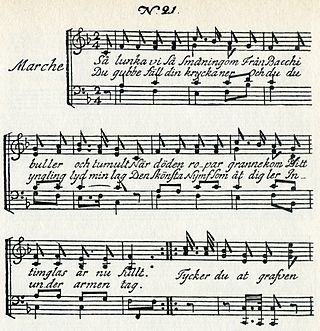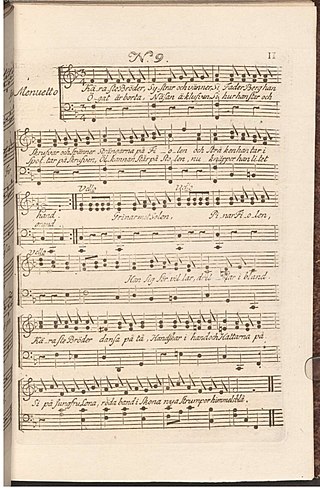Related Research Articles

Johan Henric Kellgren was a Swedish poet and critic.
Maria Kristina Kiellström, known as Maja Stina, was a Swedish silk worker and alleged prostitute, and most famously the fictional demimonde prostitute or Rococo "nymph" Ulla Winblad in the songs called Fredman's Epistles by Sweden's troubadour, Carl Michael Bellman, who made her a major character in his work.

Carina Burman is a Swedish novelist and literature scholar. Her research has been focused on Swedish 18th and 19th century literature. She completed her Ph.D. in literature in Uppsala in 1988 with a dissertation on the Gustavian writer Johan Henric Kellgren. Later production includes a critical edition of previously unpublished letters of the novelist and feminist pioneer Fredrika Bremer in two volumes (1996) and a biography of Bremer (2001).

Fredrica Löf, also known as Fredrique Löwen, was a Swedish stage actress. She was the first female star at the newly founded national stage Royal Dramatic Theatre, which was founded the year of her debut.

Caroline Frederikke Müller née Halle also known as Caroline Walther, was a Danish and later naturalized Swedish opera singer (mezzo-soprano). She was also active as an instructor at the Royal Dramatic Training Academy. She was a member of the Royal Swedish Academy of Music and a Hovsångare.

Marie Louise Marcadet née Baptiste was a Swedish opera singer and a dramatic stage actress of French origin. She was active in the Royal Swedish Opera as a singer, and in the Royal Dramatic Theatre and the French Theater of Gustav III as an actress. She was a member of the Royal Swedish Academy of Music from 1795.

Fredmans epistlar is a collection of 82 poems set to music by Carl Michael Bellman, a major figure in Swedish 18th century song. Though first published in 1790, it was created over a period of twenty years from 1768 onwards. A companion volume, Fredmans sånger was published the following year.

Sofia Franziska Stading was a Swedish opera singer of German origin. She is referred to as one of the more notable opera singers in Sweden during the Gustavian era. She was a Hovsångare and member of the Royal Swedish Academy of Music from 1788.

Catharina Ebba Horn af Åminne,, was a Swedish noble and the second official royal mistress of King Frederick I of Sweden from 1745 to 1748. She was one of two official royal mistresses in Sweden. She had no influence over state affairs, but she did patronise careers through her powerful connections and her position.

Countess Christina Augusta Löwenhielm, was a Swedish noblewoman and courtier. She is known for her love affair with the later Charles XIII of Sweden. She is also famous in history as one of "the three graces" of the Gustavian age; three ladies-in-waiting immortalized in the poem Gracernas döpelse by Johan Henric Kellgren, and known profiles of the epoch.

Ulrika "Ulla" Eleonora von Höpken, later von Wright, née von Fersen, was a Swedish countess and courtier. She is also famous in history as one of "the three graces" of the Gustavian age; three ladies-in-waiting immortalized in the poem Gracernas döpelse by Johan Henric Kellgren. She was a leading socialite and trendsetter in contemporary Sweden, and one of the best known personalities of the Gustavian age.

Olof Åhlström was a Swedish civil servant, composer and music publisher.
Sara Simonsdotter, called Tjocka Sara, was a Swedish brothel owner and procurer in 17th-century Stockholm. Her brothel had clientele among the royal court and became the centre of a scandal when it was revealed in 1618.

Lovisa "Louise" Augusta Meijerfeldtnée Sparre af Sundby, was a Swedish noble and courtier. She is famous in history as one of "the three graces" of the Gustavian age; three ladies-in-waiting immortalized in the poem Gracernas döpelse by Johan Henric Kellgren, and known profiles of the epoch.

Events from the year 1756 in Sweden

Så lunka vi så småningom is a song from the Swedish poet and performer Carl Michael Bellman's 1791 collection, Fredman's Songs, where it is No. 21. The song, written a few months after the death of his son Eli, is addressed to his hosts at a meal. It makes light of death, while presenting it to each person individually, of high or low rank in society. The refrain sings of a pair of gravediggers discussing whether the grave is too deep, taking repeated swigs from a bottle of brandy.

Käraste Bröder Systrar och Vänner is Epistle No. 9 in the Swedish poet and performer Carl Michael Bellman's 1790 song collection, Fredman's Epistles. The epistle is subtitled with the dedication "Til Gumman på Thermopolium Boreale och hännes Jungfrur.", Barbara Ekenberg. It describes the fictional Jean Fredman's cheerful world of brandy, women, and dance, in the setting of a tavern which is halfway to a brothel. The song ends with Fredman's credo, a celebration of everything that is delightful in life.
Barbara Suzanne Pauli was a Swedish fashion trader. She belonged to the most successful business entrepreneurs of Stockholm and described as the center figure of Stockholm fashion trade during the Gustavian age.

Henrik Jakob von Düben was a Swedish diplomat, Master of Ceremonies and Hofmarschall. Notably, he served as an envoy to the Polish-Lithuanian Commonwealth in 1767, during which time he headed the Embassy of Sweden in Warsaw until 1769 and also held the role of Minister Plenipotentiary in the Polish-Lithuanian Commonwealth.

Par Bricole is a Swedish Bacchanalian order society for men only, founded in Stockholm on 15 May 1779 in Källaren Kejsarkronan at Drottninggatan 6. The main sources of inspiration were the Freemasons and Carl Michael Bellman's sayings about Bacchus.
References
- 1 2 3 4 Hallman, Mila, Målare och urmakare, flickor och lösdrifvare: historier från gamla Stockholm, Fröléen, Stockholm, 1907
- ↑ Lennartsson Rebecka, red (2014). Från skuggsidan: folk och förbrytelser ur Stockholms historia. Stockholm: Stockholmia. Libris 16465137. ISBN 9789170312779
- 1 2 Lennartsson, Rebecka, Från skuggsidan: folk och förbrytelser ur Stockholms historia, Stockholmia, Stockholm, 2014
- ↑ Mina kärleksäventyr: En dagbok från sjuttonhundratalet. Gustaf Hallenstierna, Gardar Sahlberg - 1972 - Strängvy
- ↑ Samlaren / Sextonde årgången. 1895
- ↑ Samlade skrifter: Av Johan Henrik Kellgren. Utg. av Sverker Ek, Allan Sjöding, Otto Sylwan, Volym 7, Utgåva 1–5 . Johan Henrik Kellgren, Sverker R. Ek, Allan Edvard Sjöding, Otto Sylwan. A. Bonnier, 1936
